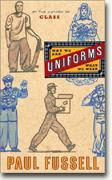Uniforms
Paul Fussell
book reviews:
· general fiction
· chick lit/romance
· sci-fi/fantasy
· graphic novels
· nonfiction
· audio books
· author interviews
· children's books @
curledupkids.com
· DVD reviews @
curledupdvd.com
newsletter
win books
buy online
links
home
for authors
& publishers
for reviewers

 |
Uniforms: Why We Are What We Wear Paul Fussell Houghton Mifflin Hardcover 192 pages November 2002 |
|
Uniforms: Why We Are What We Wear is a fun little compendium of facts on an interesting subject. This work, however, lacks the heft of Fussell's earlier works, including The Great War and Modern Memory and Class. Uniforms reads more like a haphazard collection of "scrap material" rather than a detailed analysis of its subject. Fussell also does little to answer the titular question: "why we are what we wear."
As would be expected, Uniforms talks about all manner of military attire and even the general military attitude (many a generalization here!) of a nation's people. Fussell points out that American uniform use was widely considered "sloppery." Europeans in WWII, it seems, were enraptured by the sloppiness of American army personnel, uniform and all. American soldiers were often seen "driving their jeeps with one leg outside, foot on the fender," displaying a nonchalant attitude. Besides military uniforms, Fussell also briefly points out uniforms in many other codes of dress. A nuptial dress, which is usually white, religious uniforms, and Boy Scout uniforms are but some of the examples outlined in the book. Long baggy boys' shorts and pants, we learn, are derived from prison wear as an act of rebellion against parents. Belts are taken away from inmates so they are not used as a weapon or to commit suicide, so the pants hang loose and low. Then of course there is the cute UPS truck driver in his cool brown uniform classified as "delivery chic." It seems many a woman will make extra catalog purchases just to be paid a visit by her UPS truck guy. I believe it! Often Fussell makes the most obvious of statements and tries to pass them off as analyses. For example, he says that the wearing of a uniform confers dignity and a sense of belonging to the wearer. This holds true for many organizations, from McDonald's to the United States Marine Corps. A layperson is also more liable to trust a police officer in traditional attire and the "dark blue uniform is joyously received by most citizens." And? In his book, Fussell points out the overwhelming masculinity of the subject (women came to uniforms pretty late). He also says that: "Dressing approximately like others is to don armor against contempt." Any woman who has tried buying her guy a purple shirt can attest to the verity of both of those statements. Fussell's book is quite full of interesting facts about uniforms. One wishes, though, that he had provided the matter with some more stuffing. As it stands, Uniforms is a fun look at the subject but it is not a detailed analysis of it.
|
|
|
|
 Click here to learn more about this month's sponsor! |
|
| fiction · sf/f · comic books · nonfiction · audio newsletter · free book contest · buy books online review index · links · · authors & publishers reviewers |
|
| site by ELBO Computing Resources, Inc. | |
 One of the advantages that a uniform affords its
wearer is the ability to skimp on "the work of
remaking one's external character all the time." That,
of course, is one of a uniform's many advantages, but
the flip side is a concurrent loss of individuality.
Sometimes, as in the case of Levi's blue jeans, an
effort to rebel and stand out gets adopted by so many,
that it becomes the new uniform.
One of the advantages that a uniform affords its
wearer is the ability to skimp on "the work of
remaking one's external character all the time." That,
of course, is one of a uniform's many advantages, but
the flip side is a concurrent loss of individuality.
Sometimes, as in the case of Levi's blue jeans, an
effort to rebel and stand out gets adopted by so many,
that it becomes the new uniform.